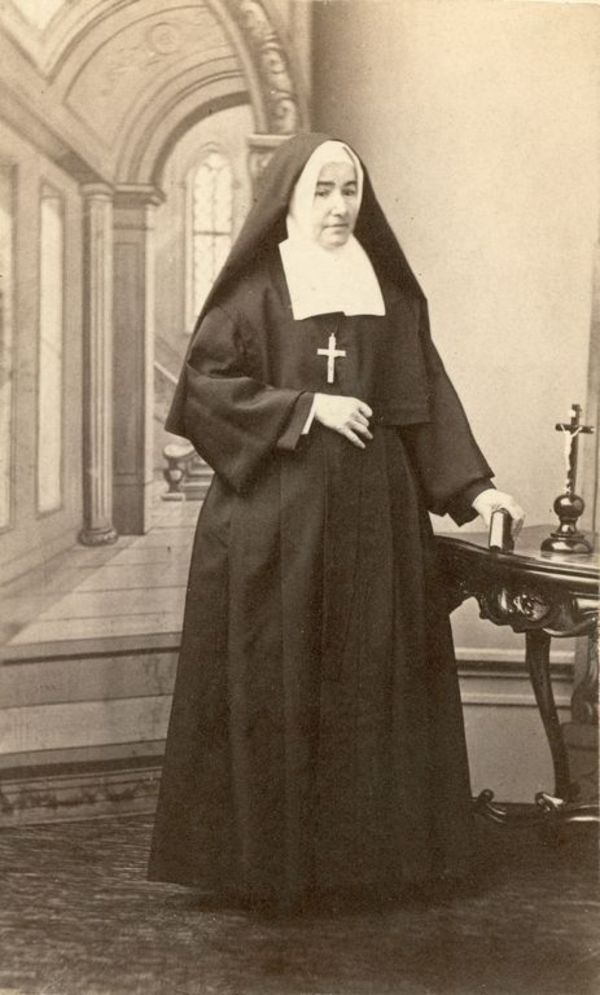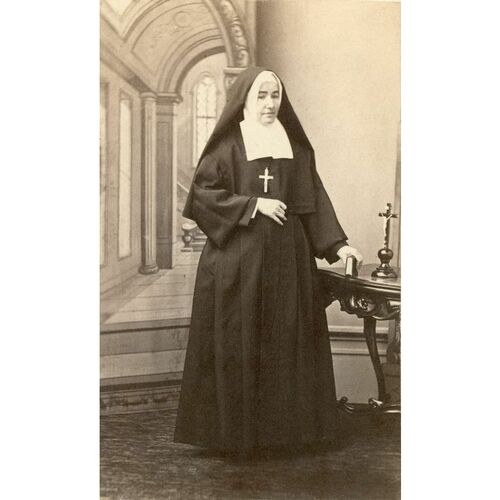
Source: Link
FISBACH (Fitzbach, Fisbacht), MARIE (baptized Marie-Joseph; also known as Marie-Geneviève), named Marie du Sacré-Cœur (Roy), founder of the Congregation of the Sisters, Servants of the Immaculate Heart of Mary (known as the Sisters of the Good Shepherd), and of the Asylum of the Good Shepherd; b. 16 Oct. 1806 at Saint-Vallier, Lower Canada, daughter of Charles Fisbacht, a day-labourer originally from Luxembourg, and Marie-Geneviève Nadeau; d. 1 Sept. 1885 at Quebec.
Marie Fisbach, whose father had died when she was very young, lived in a poverty-stricken home. While still a girl, she entered the service of the family of François-Xavier Roy, a merchant in Quebec’s Upper Town; she married him on 17 April 1828 at Cap-Santé after the premature death of his wife. Five years later she was widowed and left in sole charge of her three daughters. Cheated of most of her assets by the guardians of her two step-children, she was obliged to become a “servant” once more, this time at the presbytery of Saints-Gervais et Protais (Saint-Gervais), in order to secure her children’s future. In May 1846 her youngest daughter died, and the following September the two remaining daughters entered the ranks of the first postulants of the Grey Nuns of Quebec. A few weeks later Marie joined them as a boarder. There it was suggested that she take charge of a charitable organization “to help women in moral and social distress.” The initiator of the project was an Irish lawyer, George Manly Muir, clerk of the Legislative Assembly; he was a militant Catholic, active in the Society of St Vincent de Paul. During the course of numerous visits to Quebec prisons, Muir had concluded that there was an urgent need to establish houses which would attempt to rehabilitate women after their release.
On 11 Jan. 1850 Marie Fisbach and a companion, Mary Keogh, a young Irish orphan, set up the Asile Sainte-Madeleine (later the Maison Marie-Fitzbach) in the faubourg Saint-Jean. They were joined by six helpers and took in 20 penitents in the first year; they then moved the home to larger quarters at the corner of Lachevrotière and Saint-Amable streets in the Saint-Louis district, at the time one of the poorest and most disreputable sections of the city. Here the work of the Sisters of the Good Shepherd of Quebec would establish itself. In 1852, convinced that social and moral education were needed to complete this initial work, the director of the home started two classes, one English and one French, for 90 pupils. For income the two endeavours relied on sewing, public collections, gifts and a weekly subscription of $2.50 from the Society of St Vincent de Paul, as well as aid in kind from the seminary, the Ursuline convent, and the Hôtel-Dieu.
In 19th-century Canada East, it was normal that a social service should lead to the founding of a religious community. On 30 May 1855 the Asylum of the Good Shepherd of Quebec was incorporated, and on 2 Feb. 1856 the sisters were established canonically as the Congregation of the Sisters, Servants of the Immaculate Heart of Mary. On this occasion seven women took the first perpetual vows in a ceremony under the direction of Marie Fisbach, who had become Sister Marie du Sacré-Cœur. To the public the nuns would always be the Sisters of the Good Shepherd, from the initial name of the home. They were often confused with the Sisters of the Good Shepherd of Angers, who had arrived in Canada in 1844 and directed several houses of re-education and rehabilitation in the Montreal region. In 1867 Rome recognized the existence of the new community; its constitutions received final approval in 1921.
At the first elections in 1856 Marie Fisbach, the founder, was elected superior; she had in fact acted in this capacity during the initial phases. But she did not command unanimous support and in 1859 she took the rank of assistant; one of her earliest companions, Marie de Saint-Vincent de Paul, succeeded her as superior. Some years later Marie Fisbach renounced elective office in order to live in solitude, relieved of an active apostolate. However, she followed with interest the expansion of her work, which continued throughout her lifetime and after her death.
A whole series of social welfare services developed from Marie Fisbach’s activities. The religious sisters visited women prisoners and gave them shelter when they left prison; in addition, at the government’s request, they founded a number of reformatory houses in 1870, and eventually in 1931 they assumed full responsibility for the women’s prison. From 1874 they took unmarried mothers into “homes” for the duration of their pregnancies and then into hospitals set aside for them. They also opened the Crèche Saint-Vincent-de-Paul at Quebec for children slated for adoption, as well as the Marie-du-Temple nursery school at Pointe-aux-Trembles (Neuville, Quebec) to look after the intellectual and psychological development of these children. Finally, the sisters organized residences for elderly married women and, at Quebec, a Maison Béthanie where women pledged themselves, by a vow of constancy, to end their lives in prayer and atonement. And while they were providing a growing number of welfare services, the sisters were also extending their educational work with children who were economically and socially underprivileged.
The Sisters of the Good Shepherd early expanded their endeavours beyond Quebec City into various areas of the province, and even into the United States (1882). In time the congregation established itself in countries where there were missions – for instance, in the Union of South Africa in 1935, on the island of Grande Comore in 1958, and in Tunisia in 1965. Hence the statistics of the congregation for the 100 years or so from its foundation to 1950 are impressive In 1856 the Good Shepherd order numbered seven sisters, 31 protégées, and 150 pupils. By 1950 there were 1,283 sisters, 2,396 protégées, and 16,805 pupils. In 1975, 1,296 sisters were still looking after a large number of protégées and pupils but the growing socialization and secularization of social and educational services make it impossible to determine exactly the extent of their work.
AC, Montmagny, État civil, Catholiques, Saint-Vallier, 17 oct. 1806. Arch. de la Maison généralice des sœurs du Bon-Pasteur de Québec, Statistiques, 1955, 1975. Le Canadien, 2 sept. 1885. Le Jeune, Dictionnaire, I: 205–7. Papin Archambault, Sur les pas de Marthe et de Marie, congrégation de femmes au Canada (Montréal, 1929). L.-P. Audet, Le système scolaire, I: 77–86. [H.-R. Casgrain], L’asile du Bon-Pasteur de Québec d’après les Annales de cet institut (Québec, 1896). [Angèle Barabé, dite sœur Sainte-Henriette], Le Bon-Pasteur de Québec; un siècle d’histoire (Québec, 1949). [Georgianna Juneau, dite sœur Saint-Paul de la Croix], Mère Marie du Sacré-Cœur (1806–1885), fondatrice du Bon-Pasteur de Québec et ses collaboratrices (Québec, 1935). [Émilie Langlois, dite sœur Marie du Carmel], Les temps héroïques de notre histoire, 1850–1856 (Québec, n.d.). Sœur Marie d’Israël [Marguerite Jean], “Marie-Geneviève Fitzbach & le Bon-Pasteur de Québec,” Assoc. des religieuses enseignantes du Québec, Bull. (Québec), 3 (1964): 239–49. Sœur Saint-Antoine de Jésus [Irma Deschênes], “Une communauté du Québec,” L’Action (Québec), 12 déc. 1967: 9.
Cite This Article
Andrée Désilets, “FISBACH (Fitzbach, Fisbacht), MARIE (baptized Marie-Joseph) (Marie-Geneviève), named Marie du Sacré-Cœur (Roy),” in Dictionary of Canadian Biography, vol. 11, University of Toronto/Université Laval, 2003–, accessed January 1, 2026, https://www.biographi.ca/en/bio/fisbach_marie_11E.html.
The citation above shows the format for footnotes and endnotes according to the Chicago manual of style (16th edition). Information to be used in other citation formats:
| Permalink: | https://www.biographi.ca/en/bio/fisbach_marie_11E.html |
| Author of Article: | Andrée Désilets |
| Title of Article: | FISBACH (Fitzbach, Fisbacht), MARIE (baptized Marie-Joseph) (Marie-Geneviève), named Marie du Sacré-Cœur (Roy) |
| Publication Name: | Dictionary of Canadian Biography, vol. 11 |
| Publisher: | University of Toronto/Université Laval |
| Year of publication: | 1982 |
| Year of revision: | 1982 |
| Access Date: | January 1, 2026 |



